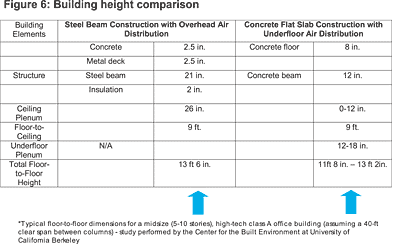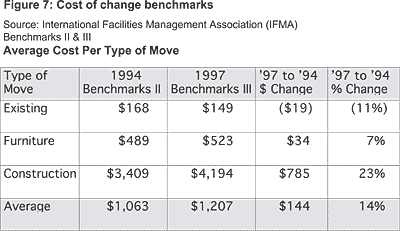Raised Access Floors: The Foundation of Flexibility and Efficiency
5. Reduced building height
By requiring less building materials, e.g., building ductwork,
the overall floor-to-floor height can be reduced, contributing
to overall cost savings. In traditional overhead HVAC distribution,
a large plenum space is required for supply air and return
air ductwork, wiring, and sprinklers. In access floors, underfloor
plenum heights are determined by the largest HVAC components
(note that minimal ductwork is used in the underfloor plenum),
requirements for underfloor cabling, and clear space for underfloor
airflow. Similarly, a smaller ceiling space is required for
return air and wire distribution. All of these factors make
a five to 10 percent reduction in floor-to-floor heights possible
when using access floors with underfloor air distribution
compared to overhead distribution. (Figure 6-Building height
comparison):
|
6. Reduced costs
Access floors can generate a positive impact on first costs
of building construction, and on life cycle building costs.
|
Construction Costs: Numerous cost comparisons from development and construction companies have shown that access floors can be highly cost competitive with traditional construction methods for the shell, fit-out, HVAC, plumbing, lighting, electrical, and communications utilities.
|
Life cycle costs: Beyond first costs, access floors can also help reduce on-going costs. (Figure 7) Cost of change benchmarks and (Figure 8) Cost of change Trends illustrate the rising cost and rate of change in typical office layouts. The cost per change has gone up 22 percent and the rate of churn has increased three percent. Access floors make the changes easier, require less time, and hence, less cost to perform.
|












